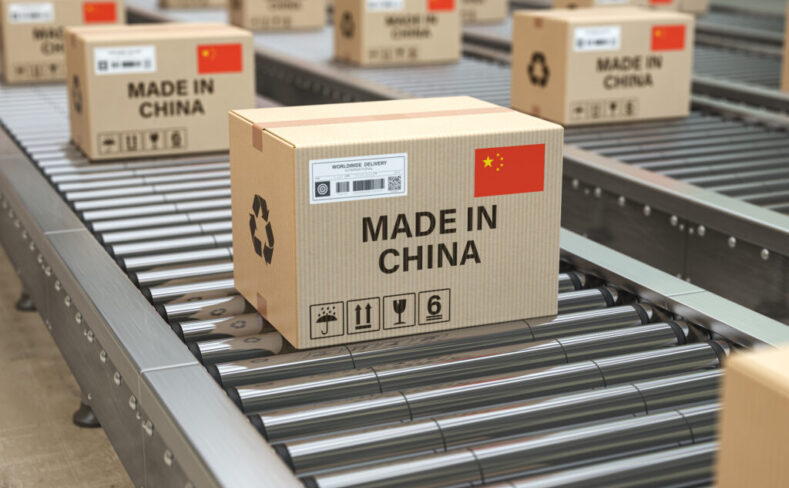
How to Purchase Wall Panels from China in 2023?
At the beginning of the new year, Chinese foreign trade enterprises began to rush to produce and receive orders. After China’s epidemic policy is turned open in 2023, there have been some positive signs in the beginning of the year.
The deputy director of the China Council for the Promotion of International Trade believes that with greater efforts to promote the policy support of stable scale and optimized structure of foreign trade, foreign trade import and export is expected to show a continuous positive trend, with a growth rate that is low and then high, and the overall positive growth is achieved.
According to a recent report by the international investment bank Goldman Sachs Group, the reopening of the Chinese economy and the full recovery of domestic demand will drive global economic growth by about 1% in 2023. Through the offline exhibition of a series of domestic export exhibitions including the full resumption of the Canton Fair. We will fully support foreign trade enterprises to participate in various overseas professional exhibitions.
We will closely cooperate with trading partners, give full play to China’s super large-scale market advantages, and expand the import of high-quality products from various countries. So as to stabilize Global trade supply chain, etc., China will continue to promote high-level opening up to make foreign trade easier, more convenient, and more rewarding.
China’s Foreign Trade Export Volume (In USD 100 Million)
| Indicators | 1990 | 1995 | 2000 | 2005 | 2021 |
| Total Value of Imports and Exports(USD 100 million) | 1154.4 | 2808.6 | 4743.0 | 14219.1 | 60501.7 |
| Total Exports | 620.9 | 1487.8 | 2492.0 | 7619.5 | 33630.2 |
| Primary Goods | 158.9 | 214.9 | 254.6 | 490.4 | 1400.7 |
| Manufactured Goods | 462.1 | 1273.0 | 2237.4 | 7129.2 | 32229.5 |
Source: https://data.stats.gov.cn/foreign-trade-and-utilization-of-foreign-capital
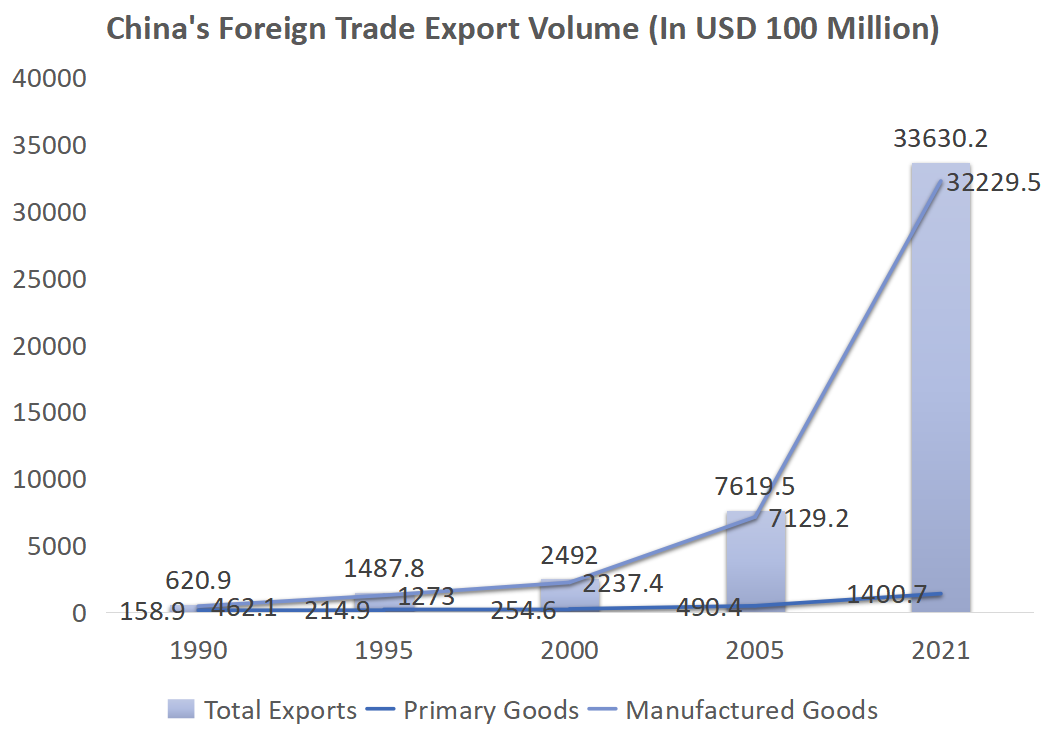
The deepening and development of China’s foreign trade in the 1990s was mainly due to the accurate grasp of the development trend of the world economy at that time and the market-oriented reform of the foreign trade system in accordance with international rules. relevant. From 1992 to 2000, about 40% of the country’s total exports have been concentrated in Guangdong, Shanghai, Jiangsu, Zhejiang and other coastal provinces.
In 2013, China started a new round of high-level opening up, and the development of foreign trade entered a new era. So far, it has maintained the status of the world’s largest exporter and second largest importer for six consecutive years, and surpassed the United States for the first time in 2014 to become the world’s largest trader of goods.
In general, the focus of China’s foreign trade development has changed from the previous scale expansion to the current high-quality development stage. At the same time, driven by the comprehensive deepening of reform and opening up, China has formed a new pattern of high-level opening up, providing China with The development of foreign trade has created a broader space.
I. Advantages and disadvantages of overseas procurement
Many merchants are looking to Asia, especially China, for product suppliers. One of the most common reasons is low manufacturing cost. Manufacturing costs in Asia can be so much lower than in North America and other parts of the world that it is difficult for many businesses to make money without manufacturing overseas.
Cheaper product costs are nice, but that’s not the only reason why Asia is such a great place to find suppliers, there are some other advantages.
Advantages
– Lower manufacturing cost.
– Suppliers generally prefer to work with smaller businesses and place orders in smaller quantities.
– Many suppliers to choose from.
– For many products, Asia may be the only place of production.
Apart from these advantages of sourcing from overseas suppliers, there are also some disadvantages that you should be equally aware of.
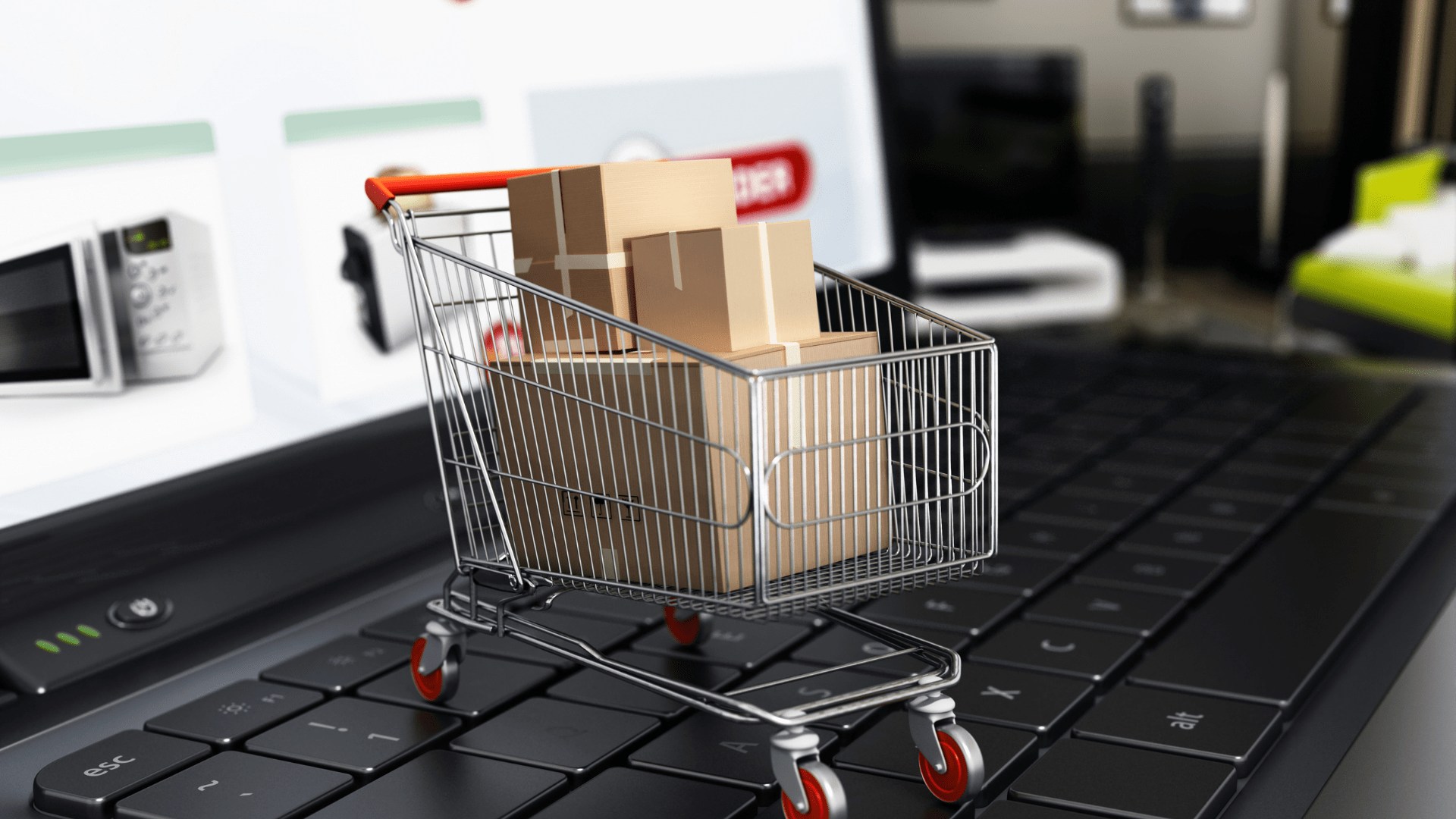
Source: https://olingoco.com/why-is-it-important-to-learn-how-to-source-products-in-china/
II. How to import products from China correctly?
Step 1: Determine the product you want to purchase
The first step to a successful import is choosing the right product. This is much harder than simply picking the cheapest item, or the item that can command the highest price tag. Some guidelines to follow when selecting a product include:
1. Choose a product you like
Enthusiasm will make you motivated. Purchasing goods from other countries needs to face many cumbersome procedures, and you have to wait for a while. You need real likes to have enthusiasm to persist.
2. Consider shipping costs
Products that can be shipped in large quantities can be much cheaper than those that cannot. Carefully consider the size of your product and how much you can carry in one shipment.
3. Consider the uniqueness of the item
If the products produced are not that unique, then maybe you should consider whether it is worth importing from abroad.
Step 2: Make a list of those Chinese exporters or suppliers who can provide you with products
1. Internet search
The easiest and most cost-effective place to start your supplier search in China is on the Internet through search engines such as Bing, Google or Yahoo and B2B sourcing platforms such as Alibaba, Global Sources and Made in China, which will Buyers connect with suppliers in China.
Advantages:
With thousands of suppliers listed on these sites, you can simplify your search by filtering only those entries labeled “Gold Member”, “Verified Supplier”, “Onsite Supplier” or “Approved Supplier” , and to increase the number of legitimate sources, good reviews indicate that the supplier is legitimate. Some B2B procurement platforms have endorsed service provider lists and supplier blacklists. For example, Alibaba has a list of banned members.
Some sites also offer special services to further protect buyers. For example, Global Sources has credit review service and supplier capability assessment service, which can provide key business information of suppliers, including company status, production capacity and product quality.
Disadvantages:
While all of these resources are helpful in developing a shortlist, it’s important to remember that many of the businesses that search engines and sourcing platforms throw up may be resellers rather than manufacturers. If you buy retail products like toys, clothes, or cheap electronics, you might be fine sourcing from such middlemen, but when you need products that must meet specific technical requirements, such as die casting, metal stamping, and plastic injection molding, it’s best to determine the manufacturing suppliers and purchase directly from them. Most importantly, this also reduces costs.
Online sourcing platforms such as Alibaba and Global Sources also rate their suppliers, which helps in the screening process. Alibaba, for example, gives its suppliers a “gold” rating, which buyers see as a sign of trustworthiness. However, it’s important to remember that any supplier who pays Alibaba an annual premium membership fee can earn Gold Supplier status, which increases the supplier’s visibility on the site. So it’s not a very trustworthy indicator of reliability.
2. Directory of online yellow pages
You can find suppliers through online outsourcing directories or through specialist sourcing firms. Here are some good resources:
– Chinese supplier guide
Made-in-China.com is a Chinese supplier guide, providing buyers with product catalogs, complete company information, contract details, corporate culture information, and factory photos.
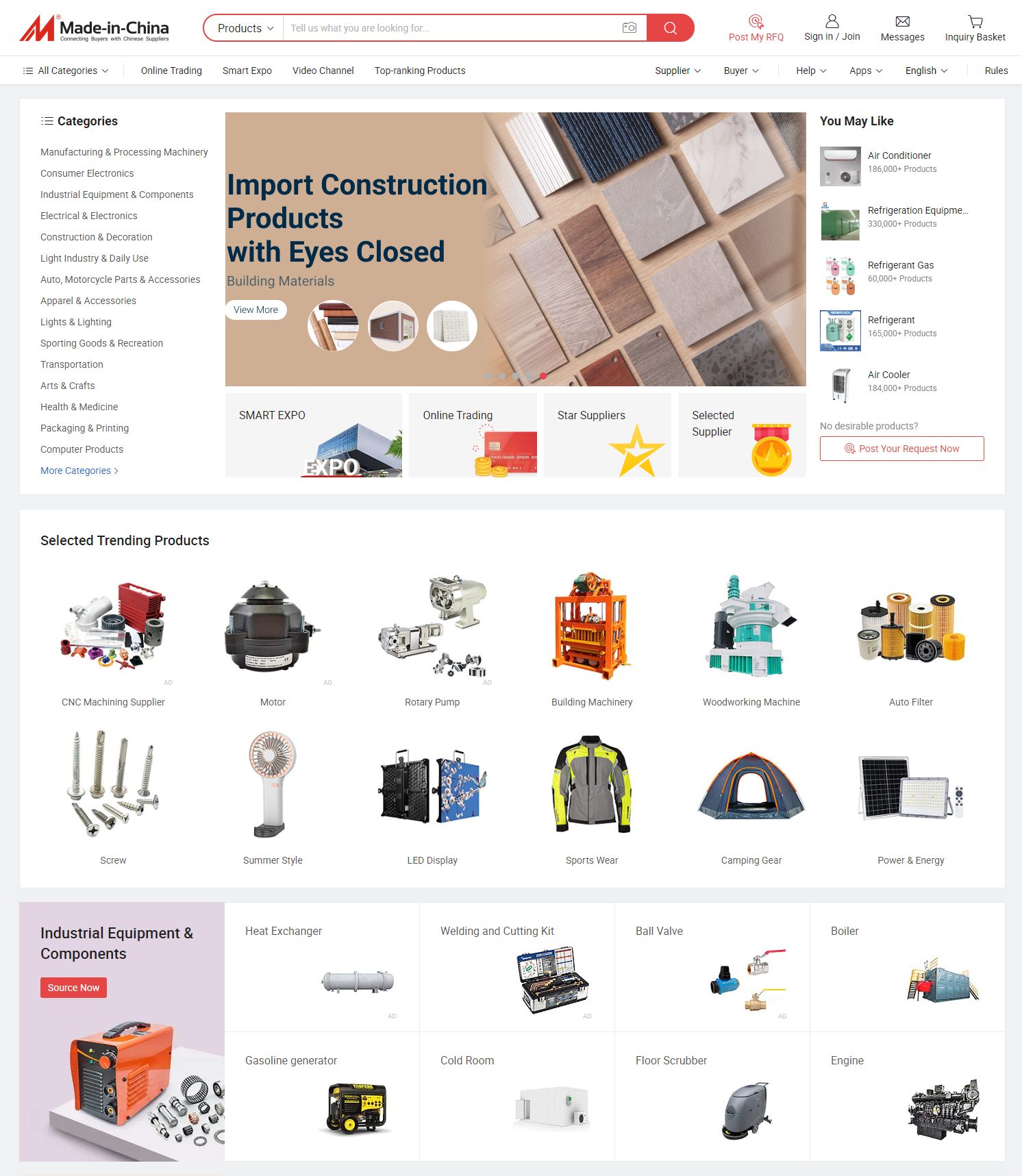
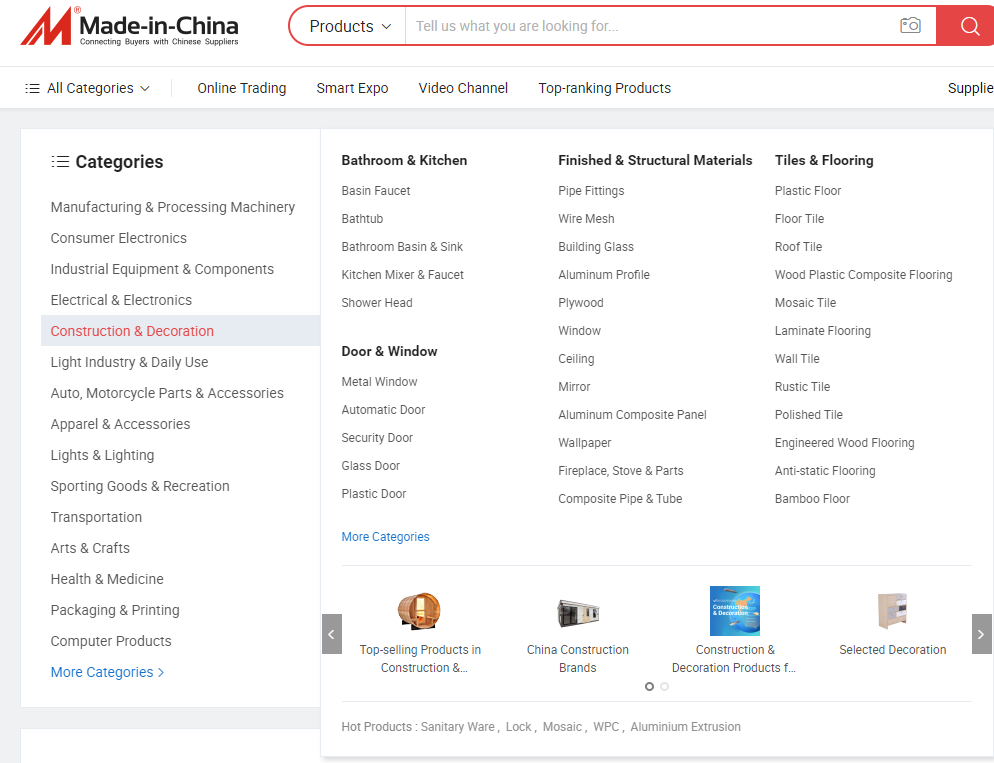
Below we take the import of wallboard products from China as an example.
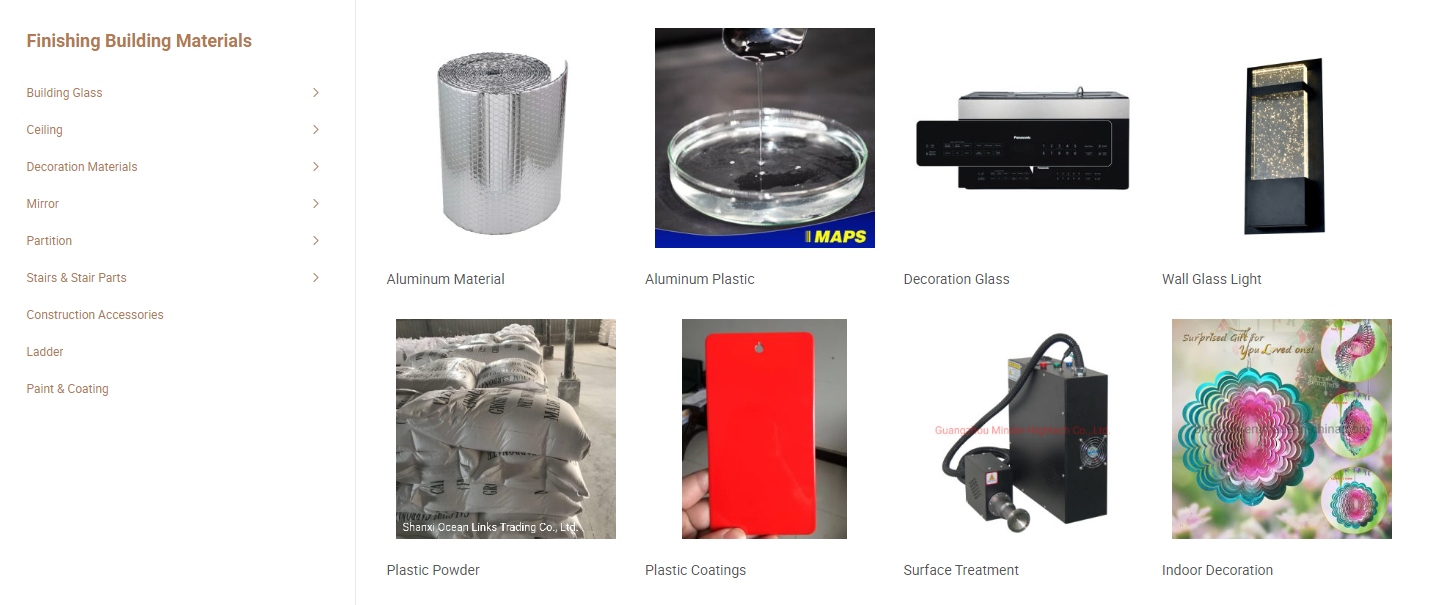
If you don’t know exactly which product you want to find, but you just want to find a large category and choose from it, you can directly click Construction & Decoration on the top or side catalog bar, and scroll down to find the Finishing Building Materials category. Then you can start picking products.
If you already know that you are looking for a certain type of wall panel in the wall panel, you can directly enter in the search box
Indoor Custom Wall Panel, Solidwood Panel, WPC Ceiling, WPC Partition, Out Door WPC Wall Panel, WPC Decoration Line, WPC Timber Tube and other keywords to find the wall panels you want.
– China yellow pages
China yellow pages is a guide to outsourcing, including product lists and manufacturers’ websites and contact information.
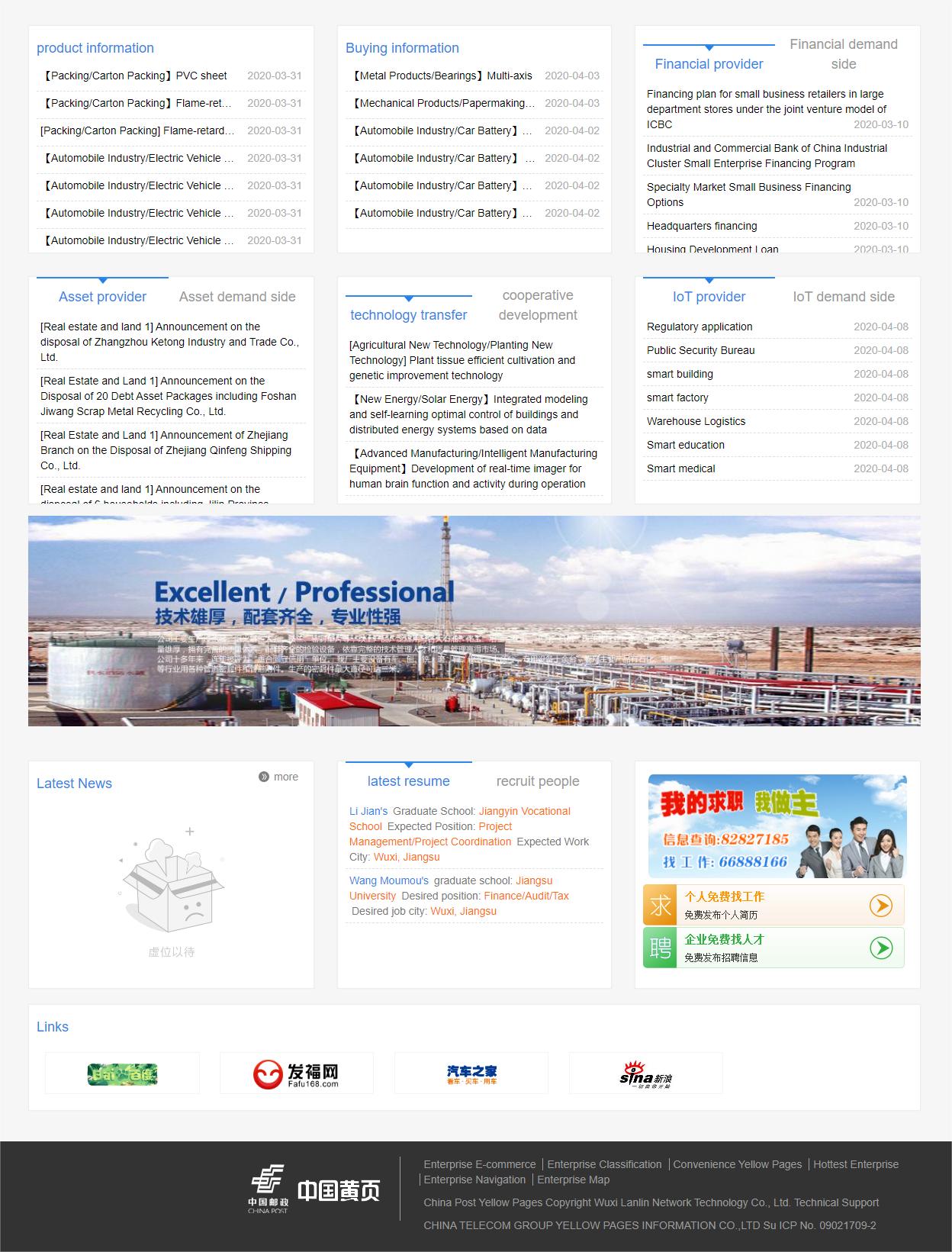
– China.cn
China.cn’s outsourcing guide covers thousands of Chinese products and provides buyers with complete contact details for each supplier. The site also provides buying and selling directions, trade show information, and trade resources for both buyers and sellers.
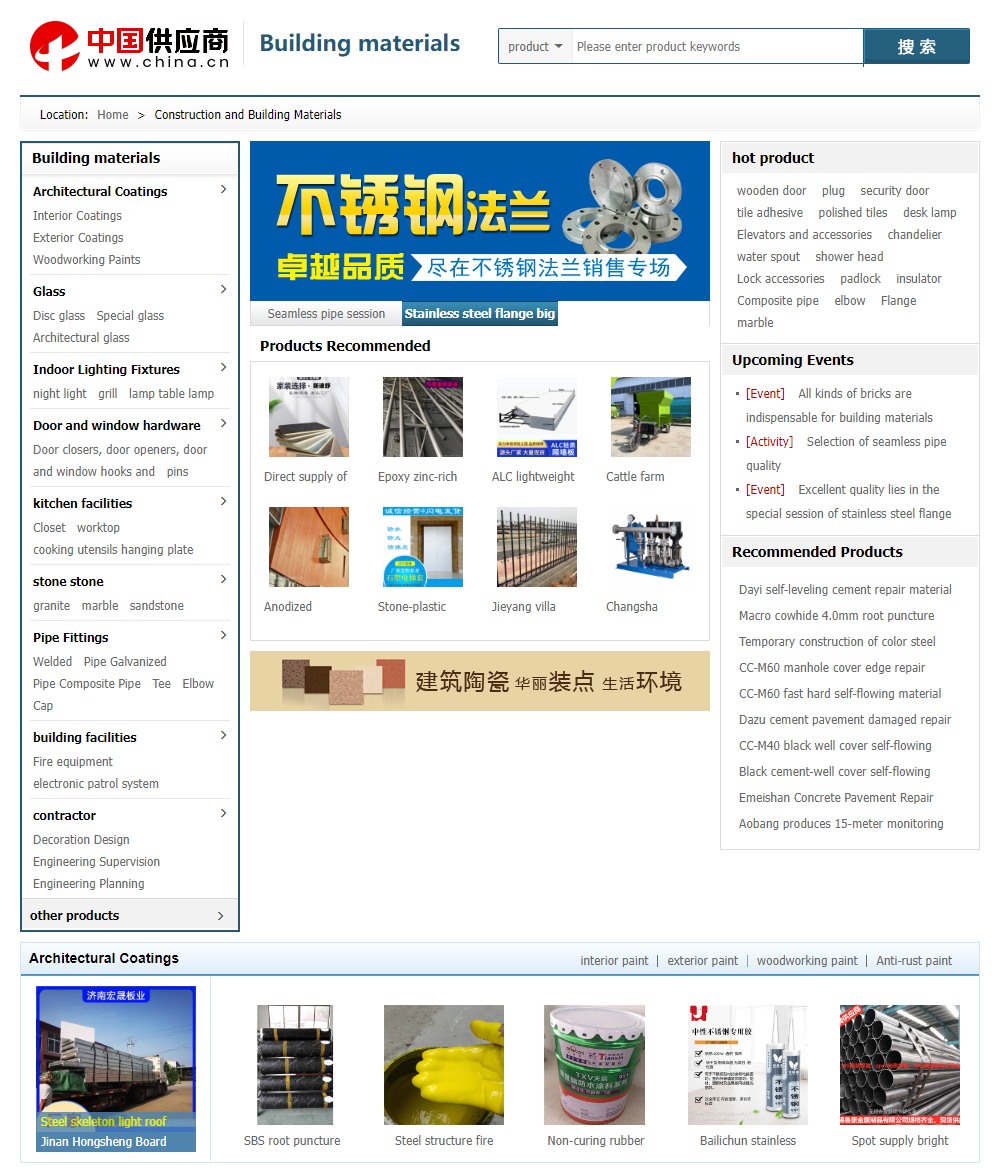
– Purchasing agent
Analema International is a professional procurement company that provides various services to buyers, including assisting in identifying suitable suppliers, assisting in negotiating with suppliers, and quality monitoring before manufacturing and shipping.
3. Social media
Social media is not necessarily an ideal platform for identifying suppliers. Only some suppliers have a presence on social media, but they can be a good source of feedback or reviews from potential suppliers.
In addition, some forums, such as Alibaba Forum, Global Sources Smart China Sourcing and China Sourcing Blog, etc. also provide good tips. Finally, be sure to check any complaints others may have shared on Ripoff Report.
4. Trade show
Trade shows are another way to find legitimate suppliers. By attending a trade show, you have the opportunity to meet potential suppliers face-to-face to discuss their companies, products, production capabilities, quality control procedures, and other key business areas. This direct interaction can help you evaluate suppliers and verify their capabilities.
Two trade shows in China are worth noticing. The Canton Fair, the biggest trade show in China, is held twice a year in Guangzhou, a city in southern China close to Hong Kong. With a vast range of products, the Canton Fair draws thousands of visitors. The largest regional trade show in China is called East China Fair, and it takes place yearly in Shanghai. Several regional trade exhibitions exist in China, and they frequently focus on a single sector. Look up Global Sources Sourcing Fairs for a particular sector.
Your nation also hosts a number of trade exhibitions with a sizable Chinese presence if you want to save the trouble of traveling abroad. These trade exhibitions frequently focus on a single industry. For instance, there are numerous Chinese exhibitors at the International Consumer Electronics Show (CES) in Las Vegas. The drawback of such shows is that you might only have access to a small number of possible Chinese suppliers because most of them won’t be there, which means you might not receive the best deals. However, you might be out of luck if you obtain a product that isn’t on display at one of these domestic trade shows.
When visiting a trade show, effective communication is crucial. The good news is that many of the exhibitors speak English and most provide handouts in English. The bad news is that many people have limited English speaking skills. As a result, if you choose to conduct business with a Chinese company, you will need to hire a translator later on during the investigation and negotiation phases. Last but not least, keep in mind that not all vendors at these trade exhibitions are producers; some are merchants or wholesalers. Be sure to ask them directly.
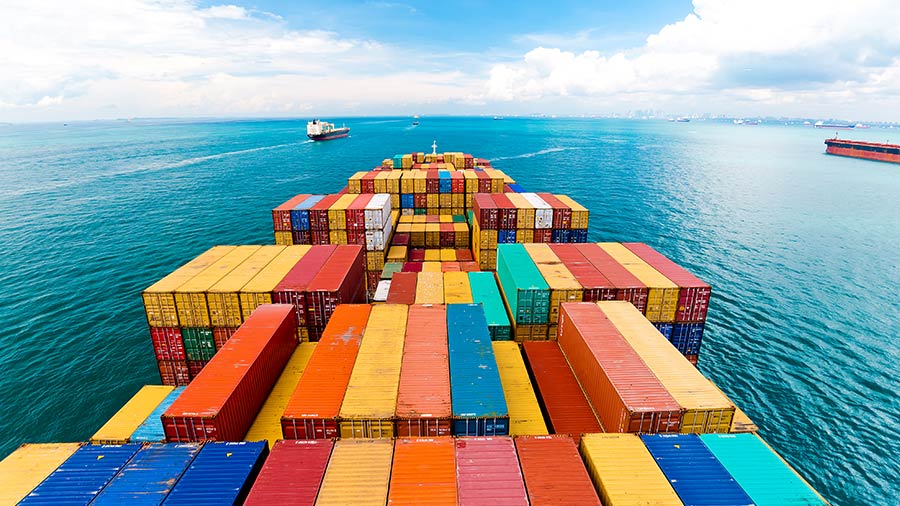
Source: https://www.china-briefing.com/china-import-export-tariffs-in-2023/
Step 3: Verify supplier
Once you have shortlisted suppliers, you need to verify their qualifications. While some obvious information is available online, you will need to assess:
1. Customer testimonials
A reputable supplier should be able to provide you with customer testimonials and testimonials. Once they offer, go check authenticity!
2. Information on business license
You want to be sure that any company you do business with is legally licensed and following all applicable trade regulations to avoid future legal issues that affect your business.
3. Production data and personnel data
Make sure you understand the relationship between the exporter and the manufacturer, whether they are indeed a factory and not a middleman. For example, do they make the product themselves, and if not, do they also charge the manufacturer a commission, or do they just work for you?
4. The name and address of the factory that produced the product
If the exporter refuses to give you the name and address of the manufacturer of the product, it is probably not a trustworthy supplier.
5. Information about the factory’s experience in producing your product
When selecting a supplier, do they have the technical expertise and production capacity to deliver what they say they can deliver. Cost is not the only consideration, quality is just as important, and the experience of the manufacturer is a good indicator of the quality of the work.
6. Product samples
Unless you are producing a new product of your own, the supplier should be able to provide you with a sample of the product to better understand its quality and know in advance what you are paying for.
You need to find out if a supplier has the necessary production capabilities, certifications, and communication and technical skills to meet your expectations in terms of quality, quantity, and delivery time. This verification can be done in several ways.
– You can ask the factory for audited accounts and statements, look at its VAT invoices to get an idea of the potential supplier’s assets and capital estimates, and whether he will be able to cover any losses in the event of a contract dispute.
– You can also determine the Chinese name of the factory, its location and the governing local government office. This office will have the factory’s registration records which you can use to verify the details they have given you.
Step 4: The way to buy goods
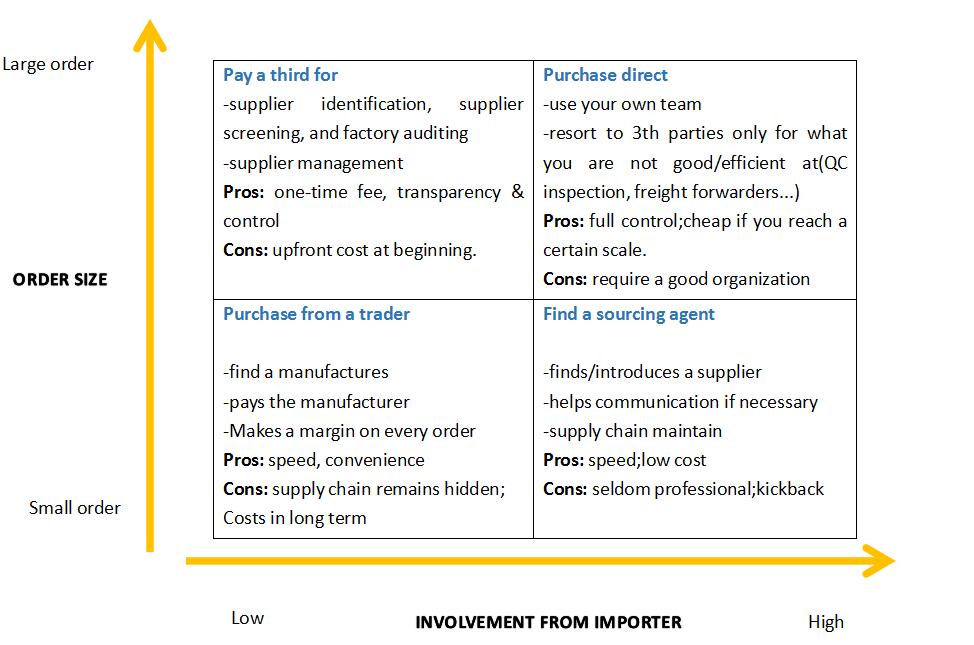
Source: https://www.supplyia.com/source-from-china/
1. Buy directly from suppliers
Once you’ve been able to identify, verify and vet potential suppliers, you can buy products directly from them or through a B2B sourcing platform. Buying directly from the supplier can save you money if all goes well, but it also puts you at risk of being scammed or getting a refund if the product is poor quality.
The mode of payment is another crucial consideration. The use of a bank letter of credit from your bank or escrow with a dependable third party are safer payment options. Credit cards, wire transfers, and other risky payment options are accessible, but many of these don’t necessarily offer trustworthy dispute channels to recover money in the event of fraud or other contractual concerns.
2. Commission-based purchasing agents
If dealing with suppliers directly sounds like too much work and risk, you can hire a China sourcing agent with experience who works on commission. These agents can aid in supplier identification, supplier verification, and communication. They may charge between 3% and 10% of the buying price.
While a sourcing agent may do some of the heavy lifting, including identifying and verifying suppliers, you still need to be closely involved in the sourcing transaction. Often, commission-based purchasing agents are not sufficiently equipped or sophisticated enough to manage production and quality control effectively or to ensure that deals are completed in a cost-effective manner. Note that there may also be hidden commissions between the sourcing agent and the Chinese manufacturer. The good news is that after working with a buying agent a few times and familiarizing yourself with the process, you can eventually manage your own transactions without their help.
3. Procurement service provider
Hire a procurement service provider that can offer a wide range of services: supplier identification, price negotiation, supply management, quality control management, logistics and shipment management, as well as other procurement-related issues if you want someone to assist you with the entire procurement process from start to finish.
Procurement service providers charge a fee to manage procurement transactions, but there are pros and cons to consider. On the plus side, a sourcing service provider can save you the hassle of identifying and verifying suppliers, production inspection, product quality control, and logistical arrangements. However, using such services deprives you of the opportunity to learn about the Chinese market. Also, using a sourcing service provider is more costly than using a commission-based sourcing agent, so expect more upfront costs when a deal is opened.
4. Trading company
If you want to buy small quantities and don’t want to deal with all the complications of sourcing in China, a trading company might be a good option. The trade-off is that your costs will generally be higher, as the trading company makes a profit on what is sourced. You’ll also find it difficult to discover information about your supply chain, and you still need to be on the lookout for product quality issues.
Sourcing goods in China presents many risks, from poor quality goods to fraud to difficulties enforcing contracts. Of course, all of these risks are not unique to China, but because China is still a developing country, the likelihood of such risks tending to occur is much greater than in developed countries. But the potential for significant cost reductions may make the risk worth it, as long as you do your research beforehand and proceed with caution.
Step 5: Negotiate with suppliers
Negotiations are not limited to price, but also deal terms, quality, negotiated terms and the type of business relationship you have. You can negotiate on almost everything except local and federal laws.
When it comes to negotiating price, remember that suppliers, like you, set a price threshold that they will never go below. Instead of getting bogged down in price negotiations, work out the other details. Explore whether suppliers can offer lower prices if order volumes increase. Vendors may also give you a discount if you pay the amount up front. If you place multiple orders, ask the supplier if you can negotiate a lower price.
Evaluating other aspects of the negotiation, rather than just focusing on the price point, may get you a better overall deal. Another reason not to focus too much on the price point is that there may be negative effects elsewhere, for example, a supplier may use inferior packaging or cheaper materials for your order.
Before negotiating with a supplier, make sure you know the market price for your product. When you compile a list of suppliers based on your research, you will usually know the prevailing exchange rate. Even if you find a supplier that you think is good, talk to different factories. You can use an offer from one of the factories to negotiate with another.
By ensuring that every communication you have with your suppliers is as straightforward as possible, you can avoid costly mistakes and delays. You can trace most supply issues to communication issues—whether due to language or cultural misunderstandings. Often you may understand the words, but not the vendor’s intent. Write everything down as clearly and in detail as possible. There is no room for any assumptions!
Step 6: Start ordering products
After receiving a quote from the manufacturer, you can now choose the best price among all offers and order the product, telling them where you are. Ask the supplier about the payment method and delivery date. Then you need to pay about 30% deposit, and the balance should be paid before shipment. This means you risk your deposit, but you have full control over the balance, which needs to be paid after quality control and lab testing.
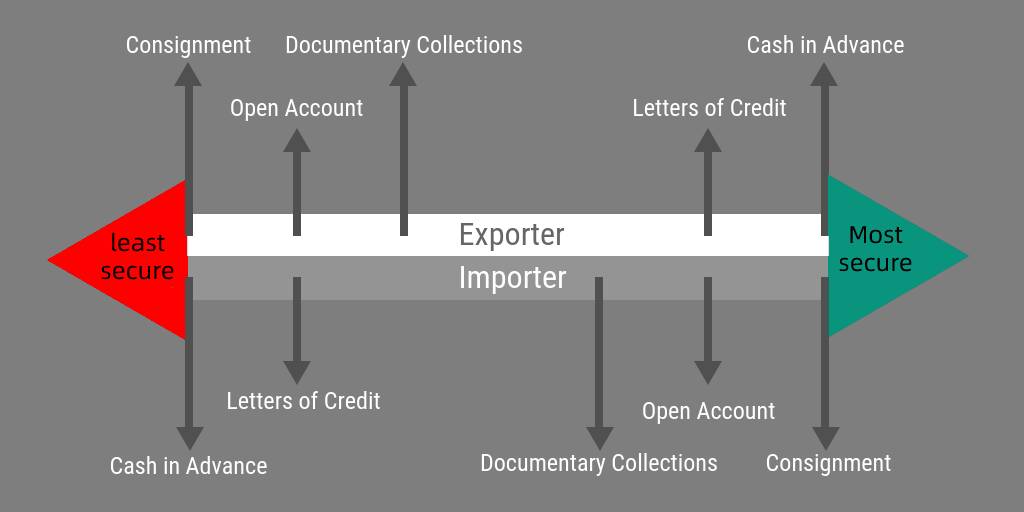
Source: https://www.supplyia.com/source-from-china/
Step 7: Pay through legal channels to avoid illegal remittances
You must choose a legal, safe and reliable payment method. If you’re using an e-commerce site, check out Alibaba Trade Assurance. When sending money to China, the key is to follow these golden rules:
1. Never transfer money to personal accounts via any payment method
Always ask for details of the business account of the company with which you are dealing. If the other party can’t provide it, don’t do business with them. Don’t make excuses to deposit money into personal accounts unless you no longer want to see your money or promised merchandise.
2. Draft a strong agreement
Ideally, before you pay a potential supplier, you must secure your interests by drafting a strong payment term in the agreement you sign with them. These terms relate to the timing of payment and the choice of payment method.
Step 8: Do a quality control check
While a good production agreement is an excellent way to start building a relationship with a supplier, regular quality control checks are also necessary so you can ensure the quality of your product meets your standards. This prevents costly mistakes in the future. Studies have shown that late problems found in the production process are always more costly than early problems.
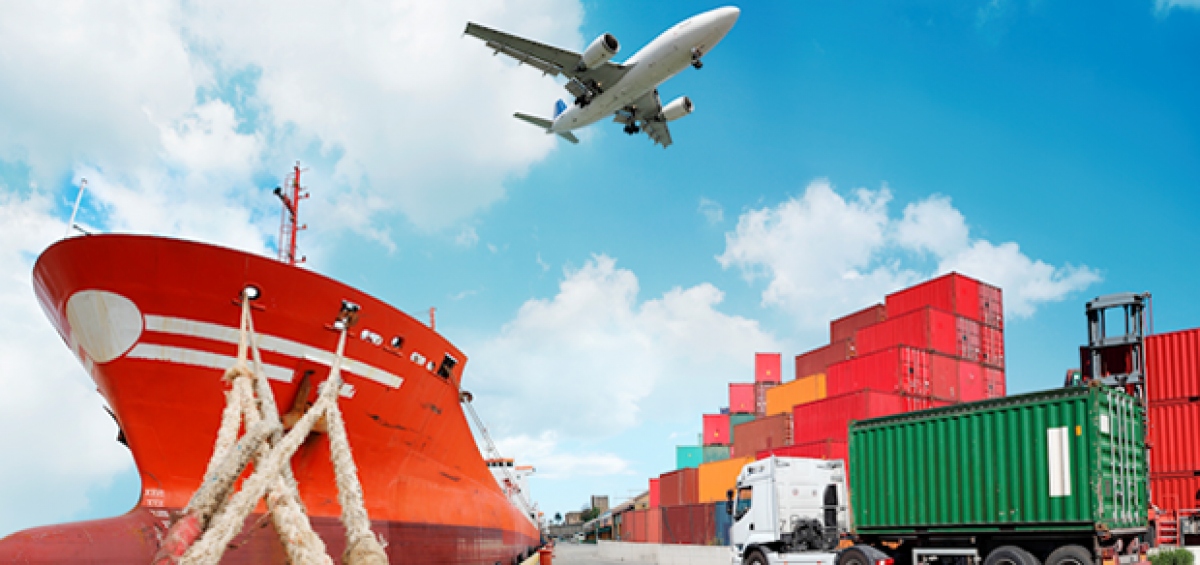
Source: https://cnsourcelink.com/how-to-import-from-china/
Step 9: Use a professional freight forwarder to safely handle the cargo
Finally, find a professional freight forwarder to deliver your goods safely and efficiently. Likewise, you’ll want to look at the company’s credentials, experience, and employment history. You’d better know the basics of this industry to decide who is a better fit to hire.
Look for companies with incomplete information, companies that claim to get the job done in a short amount of time, or companies with extremely low costs. These companies are most likely scammers. Instead, choose a reputable company with a good price and good timing. Don’t be afraid to ask each shortlisted company these questions and details so you can make the right decision.
Now sit back and relax waiting for your ordered product to arrive. When you receive a product, you must check for quality levels and defects. The last thing you want to do is check for damaged or fragile products. If you are not satisfied, you can contact the factory and ask them to replace it.
Quick Quotation



